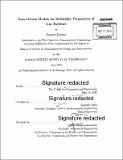Data-driven models for reliability prognostics of gas turbines
Author(s)
Kumar, Gaurev
DownloadFull printable version (6.047Mb)
Other Contributors
Massachusetts Institute of Technology. Computation for Design and Optimization Program.
Advisor
Saurabh Amin.
Terms of use
Metadata
Show full item recordAbstract
This thesis develops three data-driven models of a commercially operating gas turbine, and applies inference techniques for reliability prognostics. The models focus on capturing feature signals (continuous state) and operating modes (discrete state) that are representative of the remaining useful life of the solid welded rotor. The first model derives its structure from a non-Bayesian parametric hidden Markov model. The second and third models are based on Bayesian nonparametric methods, namely the hierarchical Dirchlet process, and can be viewed as extensions of the first model. For all three approaches, the model structure is first prescribed, parameter estimation procedures are then discussed, and lastly validation and prediction results are presented, using proposed degradation metrics. All three models are trained using five years of data, and prediction algorithms are tested on a sixth year of data. Results indicate that model 3 is superior, since it is able to detect new operating modes, which the other models fail to do. The turbine is based on a sequential combustion design and operates in the 50Hz wholesale electricity market. The rotor is the most critical asset of the machine and is subject to nonlinear loadings induced from three sources: i) day-to-day variations in total power generated by the turbine; ii) machine trips in high and low loading conditions; iii) downtimes due to scheduled maintenance and inspection events. These sources naturally lead to dynamics, where random (resp. forced) transitions occur due to switching in the operating mode (resp. trip and/or maintenance events). The degradation of the rotor is modeled by measuring the abnormality witnessed by the cooling air temperature within different modes. Generation companies can utilize these indicators for making strategic decisions such as maintenance scheduling and generation planning.
Description
Thesis: S.M., Massachusetts Institute of Technology, School of Engineering, Center for Computational Engineering, Computation for Design and Optimization Program, 2015. Cataloged from PDF version of thesis. Includes bibliographical references (pages 69-70).
Date issued
2015Department
Massachusetts Institute of Technology. Computation for Design and Optimization ProgramPublisher
Massachusetts Institute of Technology
Keywords
Computation for Design and Optimization Program.